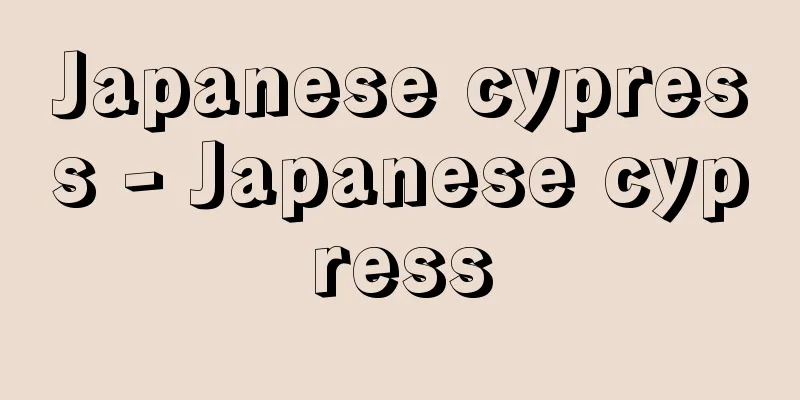Takahama Kyoshi - Takahama Kyoshi

|
Haiku poet and novelist. Born on February 22, 1874 (the 20th according to a note on his navel) in Nagamachi Shincho, Matsuyama City (present-day Minatocho 4-chome). His real name was Kiyoshi. His father, Ikeuchi Shoshiro Masatada (later Nobuo), was the domain's swordsmanship supervisor, and his mother was Ryu. In 1882 (Meiji 15), he inherited the Takahama family name from his grandmother's family. From middle school, he became close friends with Kawahigashi Hekigoto and aspired to become a writer. He showed his haiku to his senior, Masaoka Shiki, and was given the pen name Kyoshi, which is the same pronunciation as his real name. In September 1892, he entered the former Third High School in Kyoto, and Hekigoto enrolled later, so they lived together and interacted with each other as haiku friends. After the educational reform, they both transferred to Sendai's Second High School, but with a strong desire for literature, they both dropped out and moved to Tokyo in 1894. Although his ambition was to write novels, he started writing haiku under the influence of Shiki, and Shiki introduced Kyoshi's haiku in a review of "Vertical and Horizontal" in the newspaper Nippon's Haikai of the 29th Year of the Meiji Era. In 1897, he married Ohata Ito. In October 1898, Kyoshi took over the magazine Hototogisu, which had been published in Matsuyama by Yanagiwara Kyokudo with Shiki's support, and thereafter this magazine became the main focus of Kyoshi's activities. In 1901 (Meiji 34), he founded Haishodo, a publisher of haiku books. Shiki's descriptive writing also extended to prose, and he was enthusiastic about descriptive writing. In 1905, he published Natsume Soseki's "I Am a Cat" in "Hototogisu," which caused a great stir. Inspired by this, he published his own novels, and in 1908 published the short story collection "Keito." He was given the name of the "Yoyoha" group due to Soseki's preface to a long piece of writing. In the same year, he serialized the long story "Haiku Master" in the "Kokumin Shimbun." Meanwhile, his ally Hekigoto, who had already set out on his own path after Shiki's death in September 1902, criticized the publication of "Hototogisu," a travel journal about his nationwide travels, as a novel magazine from August 1906, and sought to popularize the new trend. Kyoshi moved to Kamakura in 1910 and resigned from the Kokumin Shimbunsha newspaper to revive the declining fortunes of Hototogisu by reviving the miscellaneous poems column in the July 1913 issue. In 1913 (Taisho 2), he expressed his determination as a conservative to protect the traditional forms and seasonal words of haiku in opposition to the new trends of poems by Hekigoto and others in his poems "When frost falls, the castle of law uses the frost as a shield" and "Spring breeze, I stand on the hill filled with fighting spirit." With this return to the haiku world, Hototogisu produced such poets in the Taisho period as Watanabe Suiha, Murakami Kijo, Iida Dakotsu, Maeda Fura, Hara Seki Tei, Hasegawa Reiyoshi, Hasegawa Kanajo, and Nomura Hakugetsu. From the claim of objective depiction to the Showa period, he preached that haiku was a form of flower and bird poetry, and produced such poets as Mizuhara Shuoushi, Yamaguchi Seishi, Awano Seiho, and Takano Suju, known as the 4S, as well as Hino Sojo, Kawabata Bosha, Matsumoto Takashi, Tomiyasu Fusei, Yamaguchi Seison, Nakamura Kusatao, Nakamura Teijo, and Hoshino Tatsuko, and the "Hototogisu" magazine was at its peak in the haiku world. He also continued to write descriptive novels, and in 1915 he serialized the long novel "Two Persimmons," which depicts Shiki's later years, in the Tokyo Asahi Shimbun and was published by Shinbashido in May. It was largely due to Kyoshi's influence that "The Hototogisu" introduced not only Soseki but also Torahiko Terada, Sachio Ito, Takashi Nagatsuka, Miekichi Suzuki, and Yaeko Nogami to the literary world. Kyoshi visited Manchuria (northeastern China) and Korea in 1924, and travelled to Europe in 1936 (Showa 11) to broaden the world of haiku and introduce it to foreign countries. During and after the war, he evacuated to Komoro in Nagano Prefecture, and wrote "Komoro 100 Ku" (1946), including the famous poem "Yamaguni no chowa arashi to omozu ya" (The butterflies of the mountain country are so rough, don't you think?), and "Rainbow" (1947), a novel depicting the poignant and beautiful love between teacher and student. In March 1951 (Showa 26), he handed over the selection of miscellaneous poems in "Hototogisu" to his eldest son, Toshio. In 1954, he was awarded the Order of Culture. He passed away on April 8, 1959. His posthumous name was Kyoshian Kogin Chinju Koji. He is grave at Jufuku-ji Temple in Kamakura. [Kiyoto Fukuda] "The Complete Definitive Works of Takahama Kyoshi, 15 volumes and 1 supplementary volume (1973-75, Mainichi Shimbun)" ▽ "Two Persimmons" (1986, Nagata Shobo) ▽ "Takahama Kyoshi, Expanded and Revised Edition, by Ohno Rinka (1949, Shichiyosha)" ▽ "Takahama Kyoshi, by Ohno Rinka (1993, Japan Library Center)" ▽ "Takahama Kyoshi Studies, by Yamaguchi Seishi and others (1974, Ubunshoin)" ▽ "Takahama Kyoshi, by Kiyosaki Toshiro (1980, Ohfusha)" ▽ "Takahama Kyoshi, Definitive Works, by Mizuhara Shosoushi (1990, Nagata Shobo)" ▽ "An Introduction to Takahama Kyoshi, by Onda Ko (1995, Ohfu)" ▽ "Takahama Kyoshi, edited by Motoi Hide (1996, Kagyusha)" ▽ "Takahama Kyoshi Theory" by Takeo Nakaoka (1997, Kadokawa Shoten) " "On Haiku - Takahama Kyoshi" by Zennosuke Naruse (2005, Mahoroba Shobo)" "Takahama Kyoshi - The Person and Literature" by Masatoshi Nakata (2007, Bensei Publishing) [References] | | | | | |Source: Shogakukan Encyclopedia Nipponica About Encyclopedia Nipponica Information | Legend |
|
俳人、小説家。明治7年2月22日(臍(ほぞ)の緒書(おがき)では20日)松山市長町新丁(現湊(みなと)町4丁目)に生まれる。本名清。父池内庄四郎政忠(しょうしろうまさただ)(のちに信夫(のぶお))は藩の剣術監、母は柳(りゅう)。1882年(明治15)祖母の実家高浜姓を継ぐ。中学時代より河東碧梧桐(かわひがしへきごとう)と親しみ文学に志し、先輩正岡子規(しき)に俳句を示し、本名と同音の虚子の雅号を与えられる。1892年9月、京都の旧制第三高等学校入学、碧梧桐も後れて入学同居し俳友とも交わった。学制改革でともに仙台の二高に移ったが、文学への念強く1894年そろって退学上京した。志は小説にあったが、子規の影響で句作し、子規は新聞『日本』の『明治二十九年の俳諧(はいかい)』で「縦横」の評で虚子の句を紹介した。1897年大畠(おおはた)いとと結婚。松山で柳原極堂が子規後援で発行していた『ホトトギス』を1898年10月自らの手に移し、以後虚子の活動の主力はこの雑誌によった。1901年(明治34)俳書出版の俳書堂設立。子規の写生主義が散文に及んだ写生文にも熱心で、1905年夏目漱石(そうせき)の『吾輩(わがはい)は猫である』を『ホトトギス』に掲げた反響大きく、その刺激で自らも小説を発表し、08年短編集『鶏頭』を出版。長文の漱石の序で余裕派の名も与えられた。この年『国民新聞』に長編『俳諧師』連載。一方、すでに1902年9月子規没後独自の道へ進んだ盟友碧梧桐は、06年8月から全国遍歴の旅信中『ホトトギス』の小説雑誌化を批判し新傾向への普及を計った。 虚子は1910年鎌倉に居を移し、また国民新聞社を辞して衰運の『ホトトギス』を挽回(ばんかい)するため12年7月号より雑詠欄を復活した。1913年(大正2)「霜降れば霜を楯(たて)とす法の城」「春風や闘志いだきて丘に立つ」の句に、碧梧桐らの新傾向句に対し、俳句伝統の定型、季語を守る守旧派の決意を表明した。この俳壇復帰で大正期、『ホトトギス』から渡辺水巴(すいは)、村上鬼城(きじょう)、飯田蛇笏(だこつ)、前田普羅(ふら)、原石鼎(せきてい)、長谷川零余子(れいよし)、長谷川かな女、野村泊月(はくげつ)らが輩出した。客観写生の主張から昭和期に及んで俳句は花鳥諷詠(ふうえい)と説き、4Sとよばれた水原秋桜子(しゅうおうし)、山口誓子(せいし)、阿波野青畝(せいほ)、高野素十(すじゅう)をはじめ、日野草城、川端茅舎(ぼうしゃ)、松本たかし、富安風生、山口青邨(せいそん)、中村草田男(くさたお)、中村汀女(ていじょ)、星野立子(たつこ)らを出し、『ホトトギス』は俳壇において全盛の観があった。写生文小説も書き続け、子規晩年を描く長編『柿(かき)二つ』を1915年『東京朝日新聞』に連載し、5月新橋堂から刊行した。『ホトトギス』から漱石のほか寺田寅彦(とらひこ)、伊藤左千夫(さちお)、長塚節(たかし)、鈴木三重吉、野上弥生子(やえこ)らを文壇に送った点は、虚子の力に負うところが大きい。 虚子は1924年満州(中国東北)、朝鮮を訪れ、また36年(昭和11)渡欧し句境を広め、また海外に俳句を示した。戦中戦後は長野県小諸(こもろ)に疎開、名吟「山国の蝶(ちょう)は荒しと思はずや」などの『小諸百句』(1946)や、せつなく美しい師弟愛を描く小説『虹(にじ)』(1947)も書いた。1951年(昭和26)3月『ホトトギス』雑詠選を長男年尾に譲る。54年文化勲章受章。昭和34年4月8日永眠。法名虚子庵高吟椿寿居士。墓は鎌倉・寿福寺にある。 [福田清人] 『『定本高浜虚子全集』15巻・別巻1(1973~75・毎日新聞社)』▽『『柿二つ』(1986・永田書房)』▽『大野林火著『増補改訂版 高浜虚子』(1949・七洋社)』▽『大野林火著『高浜虚子』(1993・日本図書センター)』▽『山口誓子他著『高浜虚子研究』(1974・右文書院)』▽『清崎敏郎著『高浜虚子』(1980・桜楓社)』▽『水原秋桜子著『定本高浜虚子』(1990・永田書房)』▽『恩田甲著『入門高浜虚子』(1995・おうふう)』▽『本井英編著『高浜虚子』(1996・蝸牛社)』▽『中岡毅雄著『高浜虚子論』(1997・角川書店)』▽『鳴瀬善之助著『俳句について――高浜虚子をめぐって』(2005・まほろば書房)』▽『中田雅敏著『高浜虚子――人と文学』(2007・勉誠出版)』 [参照項目] | | | | | |出典 小学館 日本大百科全書(ニッポニカ)日本大百科全書(ニッポニカ)について 情報 | 凡例 |
>>: Takahama [town] - Takahama
Recommend
semipalmate
...only in the Pelecaniformes), palmate (the firs...
August von Kotzebue
1761‐1819 German playwright. Born in Weimar. Went ...
Wilhelm Meister Theory
…F. Schlegel's Athenaeum Fragments, Idea Frag...
Rhizopus stolonifer (English spelling) Rhizopus stolonifer
…[Tsubaki Keisuke]. . . *Some of the terminology ...
Kofu duty
The Edo Shogunate established this position under...
bifteck
...It is a dish in which fillets are grilled or p...
Siberia and the Exile System
Based on his vivid experiences, he published Tent...
Perry, WJ
…In the history of ethnology, diffusionism became...
Primula japonica (English spelling) Primula japonica
… [Ken Inoue]. … From [Primula] … [Munemin Yanagi...
Cosmetics - cosmetics
The Pharmaceutical Affairs Law defines cosmetics ...
transference neurosis
...Especially in transference situations, the fix...
Blackley, CH (English spelling)
…In 1565, Italian physician Botaro described alle...
Trimeresurus tokarensis (English spelling)
… [Takahiro Matsui]. … *Some of the terminology t...
Medici family - Medici
A distinguished family of Florence, Italy, and pa...
Arnohold Carberg & Co. (English)
…Loans to overseas Chinese [Takeshi Hamashita]. …...


![Togakushi [village] - Togakushi](/upload/images/67cc54228b59c.webp)






